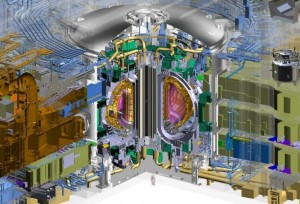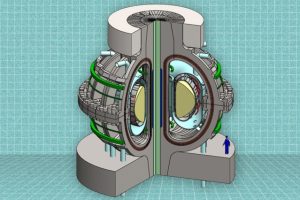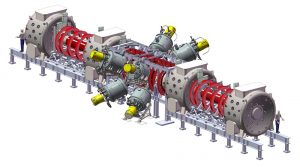The Prospect of Fusion Energy
Destined to always be the energy source of the future?
By: Derek A. Sutherland, ASP Adjunct Fellow
There is a long-standing quip within the fusion research and development community that fusion is the energy source of the future, and always will be. From an outsider’s perspective, it is straightforward to justify the level of skepticism that some people have concerning whether fusion will ever be a viable energy source to displace conventional ones. Excessively long timelines, large costs for research and development, scientific and engineering setbacks, plus the lack of a demonstration of a controlled fusion power plant producing electricity may suggest failure to an untrained eye.

ITER’s Design
However, it is important when assessing the future viability of any nascent technology to address both advancements and setbacks, with their sum defining net progress. The performance of various approaches to fusion energy, from magnetic to inertial confinement and various concepts in-between, has advanced considerably over the past decades. A recent article by Dr. Stewart Prager and Dr. Michael Zarnstorff outlines these advancements, and future opportunities. As one example, plasma performance and reactor technology has improved immensely for the leading candidate for controlled fusion power called the tokamak. The first net-gain fusion reactor called ITER, based on the tokamak concept, is being built and is slated to produce 500 megawatts (MW) of fusion power. ITER is designed to reach a power gain of ten, meaning, the fusion power produced will be around ten times the amount required to keep the reactor going. ITER, though timelines have been delayed considerably and cost overruns are ever present, will be a monumental step forward in proving fusion is a scientifically viable energy source. In short, when considering the advancements and setbacks of the entirety of the fusion field, we are most certainly progressing.
One issue that is not able to be addressed with the ITER project, but will become increasingly more important as the community progresses towards a commercial power plant demonstration, is the economic viability of fusion energy. Even while ITER is being constructed and much effort is being expended to ensure the project is a success, various organizations within the fusion sector are exploring improved concepts that could make fusion more economically competitive with conventional energy sources, if not outperform them. Additionally, as renewable energy becomes cheaper over the next years to decades, it will become even more important for fusion energy research programs to strive for both scientific and economic success.

MIT’s ARC design
There are multiple groups striving to make more cost-effective fusion power concepts; providing just a few examples conveys marked diversity of ideas within this research community. The first is the high-field tokamak concept called ARC from MIT that exploits very high magnetic fields to reach large fusion power densities, allowing for smaller tokamak reactors to be imagined. Spherical tokamaks, which exploit higher plasma pressures and more efficient use of magnetic fields, such as NSTX-U at the Princeton Plasma Physics Laboratory (PPPL) and at international sites such as MAST-U in the UK, also introduce potential cost savings from their more compact sizes. Other magnetic fusion concepts, such as stellarators that exploit some flavor of quasi-symmetry to improve plasma performance, like HSX at the University of Wisconsin, or spheromaks at the University of Washington and CTFusion, and field-reversed configurations at Tri-Alpha Energy. These mentioned concepts are at least partly geared towards reducing costs with simpler, more compact reactor

Tri Alpha’s FRC reactor design
designs. Another promising approach to fusion that could prove to be more cost-effective than the mainline approaches is magneto-inertial fusion (MIF), which is being explored by both public and private institutions, such as MagLIF at Sandia National Laboratory, and acoustically imploding magnetized plasma targets at General Fusion in Canada.
Considerable risk is involved with the development of any new technology; the unfortunate reality is that these concepts, along with others not mentioned simply for brevity, may not prove to be successful pathways to economical fusion power. Due to this uncertainty, it is challenging to convince politicians, shareholders, and the public that greater amounts of capital should be devoted to developing this rather elusive form of energy. However, as any investor understands quite well, increased risk should be balanced by the potential for more generous returns, and so is the case with fusion energy.
Imagine a world in which economical fusion energy has been developed and brought to market. The first reactors have hit cost parity with fossil fuels after supply chains have been optimized and the manufacturing process has been streamlined. A handful of companies have acquired rights to build different types of fusion reactors. After each fossil fuel plant is retired, these companies competitively bid to construct a fusion power plant to take its place. Since fusion is a base-load energy source, such reactors necessitate minimal changes to presently available grid infrastructure. As more fusion reactors are built, carbon emissions are dramatically reduced as a greater fraction of global electricity production comes from fusion. In parallel, from the advent of remarkably cheaper, more efficient photovoltaic technology, solar power proliferates, and works in tandem with fusion power plants. Lesser energy storage requirements from the use of both energy sources accelerate the transition to a completely green power grid. The increased usage of electric vehicles further decreases anthropogenic greenhouse-gas emissions while improving air quality in metropolitan areas worldwide. Moreover, due to the economic competitiveness of fusion, solar power and other renewables, this transition is not dependent on the political wind of subsidies, or increased payments from the public via higher electricity prices. A new era of clean, safe and cheap energy has begun.
I can conceive the future I have described becoming reality. This vision is one of the reasons why I have chosen to specialize in fusion research and development, even in times when funding levels are uncertain and scientific hurdles appear unsurmountable. I work on this problem because of the immense promise of fusion energy, and its potential to positively impact our world in meaningful ways. The potential rewards from investments in fusion technology far outweigh the risks in my humble opinion. We, as the fusion community, should put a greater focus not only on the mainline research programs focused on the success of the ITER project, but also on alternative concepts that have the potential to be more cost-effective pathways towards a commercial fusion power plant. We should not consider fusion as competing against renewable energy sources; it will ultimately work in concert with them. Most importantly, we should strive to work together, within our own community and beyond, to assure more people of the potential of fusion energy as a revolutionary energy source that can help ensure the twenty-first century is a more peaceful, clean, and prosperous one than the last.
Fusion is indeed an energy source of the future, but will not always be so.






Dreams resulting in extremely expensive research/development without reward. That is fusion.
In 1965 I delighted in reading about fusion research at a time when tokamaks were the latest invention that was going to deliver endless energy to the world. Now in 2017, here I am, still reading about tokamaks and the same endless promise.
Still the dreams draw in the funding. If only ….
Oh yes, we know it will work. H-bombs deliver fusion and can destroy the world. Thwe Sun does too. All we have to do is capture the force in a controlled manner.
Volcanos deliver magma from the bowels of the Earth and change the face of the world too. All we have to do is capture the force in a controlled manner.
Leonardo da vinci dreamed of a helicopter; it took a while but we eventually got there.
What we can dream, we can do, if we put our minds to it (and it complies with the laws of Physics).
In 1850, who would have dreamed in 100 yrs we would be flying over the ocean, in style?
For those who are developing next-generation energy, there is no question that eventually the new methods they are working on or are yet-to-be-invented will make the old look like horse and buggy by comparison.
Just wait a while.